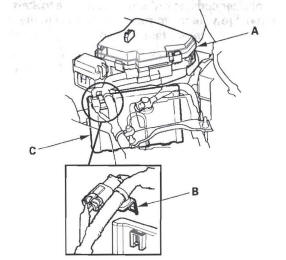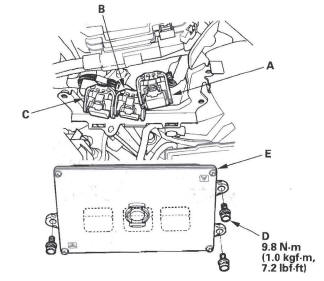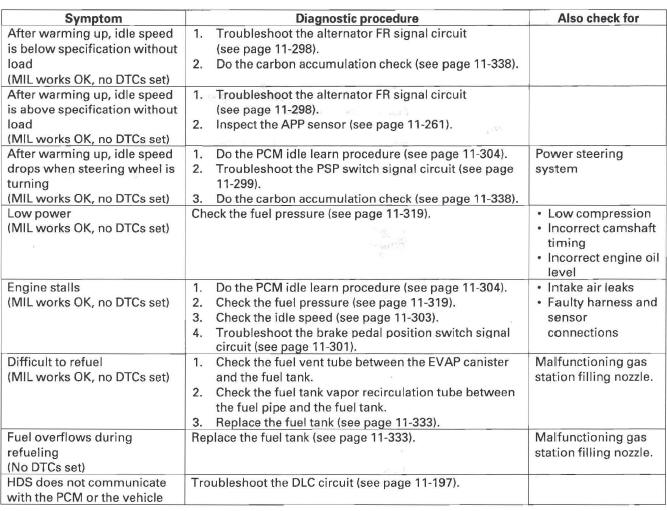Honda CR-V: General Troubleshooting Information
Intermittent Failures
The term "intermittent failure" means a system may have had a failure, but it checks OK now. If the malfunction indicator lamp (MIL) on the dash does not come on, check for poor connections or loose pins at all connectors related to the circuit that you are troubleshooting. If the MIL was on but then went out, the original problem may have been intermittent.
Opens and Shorts
"Open" and "short" are common electrical terms. An open is a break in a wire or at a connection. A short is an accidental connection of a wire to ground or to another wire. In simple electronics, this usually means something won't work at all. With complex electronics (such as PCMs) this can sometimes mean something works, but not the way it's supposed to.
How to Use the HDS (Honda Diagnostic System)
If the MIL (malfunction indicator lamp) has come on
1. Start the engine, and check the MIL (A).
NOTE: If the ignition switch is turned ON (II), and the engine is not started, the MIL stays on for 15-20 seconds.

2. If the MIL stays on, connect the HDS to the data link connector (DLC) (A) located under the driver's side of the dashboard.

3. Turn the ignition switch ON (II).
4. Check the diagnostic trouble code (DTC) and note it.
Also check the freeze data and/or on-board snapshot data, and download any data found. Then refer to the indicated DTC's troubleshooting, and begin the appropriate troubleshooting procedure.
NOTE:
- Freeze data indicates the engine conditions when the first system malfunction, misfire, or fuel trim malfunction that activated the MIL was detected.
- The HDS can read the DTC, freeze data, on-board snapshot, current data, and other powertrain control module (PCM) data.
- For specific operations, refer to the user's manual that came with the HDS.
5. If no DTCs are found, go to MIL troubleshooting.
If the MIL did not stay on
If the MIL did not stay on but there is a driveability problem, do the symptom troubleshooting.
If you can't duplicate the DTC
Some of the troubleshooting requires you to reset the PCM and try to duplicate the DTC. If the problem is intermittent and you can't duplicate the code, do not continue through the procedure. To do so will only result in confusion and possibly, a needlessly replaced PCM.
HDS Clear Command
The PCM stores various specific data to correct the system even if there is no electrical power such as when the battery negative terminal or No. 19 FI MAIN (15 A) fuse are disconnected. Stored data based on failed parts should be cleared by using the ºCLEAR COMMAND" of the HDS, if parts are replaced.
The HDS has three kinds of clear commands to meet this purpose. They are DTC clear, PCM reset, and crank (CKP) pattern clear. DTC clear command erases all stored DTC codes, freeze data, on-board snapshot, and readiness codes. This must be done with the HDS after reproducing the DTC during troubleshooting.
The PCM reset command erases all stored DTC codes, freeze data, on-board snapshot, readiness codes, and all specific data to correct the system except crank (CKP) pattern. If the crank (CKP) pattern data in the PCM was cleared, you must do the crank (CKP) pattern learn procedure. The crank (CKP) pattern clear command erases only crank (CKP) pattern data. This command is for repair of a misfire or the CKP sensor.
Scan Tool Clear Command
If you are using a generic scan tool to clear commands, be aware that there is only one setting for clearing the PCM, and it clears all commands at the same time (CKP pattern learn, idle learn, readiness codes, freeze data, on-board snapshot, and DTCs). After you clear all commands, you then need to do these procedures, in this order: PCM idle learn procedure; CKP pattern learn procedure; test-drive to set readiness codes to complete.
DTC Clear
1. Clear the DTC with the HDS while the engine is stopped.
2. Turn the ignition switch OFF.
3. Turn the ignition switch ON (II), and wait for 30 seconds.
4. Turn the ignition switch OFF, and disconnect the HDS from the DLC.
PCM Reset
1. Reset the PCM with the HDS while the engine is stopped.
2. Turn the ignition switch OFF.
3. Turn the ignition switch ON (II), and wait for 30 seconds.
4. Turn the ignition switch OFF, and disconnect the HDS from the DLC.
5. Do the PCM idle learn procedure.
Crank (CKP) Pattern Clear/Crank (CKP) Pattern Learn
Clear/Learn Procedure (with the HDS)
1. Connect the HDS to the data link connector (DLC) (A) located under the driver's side of the dashboard.

2. Turn the ignition switch ON (II).
3. Make sure the HDS communicates with the PCM. If it doesn't, go to the DLC circuit troubleshooting.
4. Select CRANK PATTERN in the ADJUSTMENT MENU with the HDS.
5. Select CRANK PATTERN LEARNING with the HDS, and follow the screen prompts.
6. The CKP pattern learn procedure is complete.
Learn Procedure (without the HDS)
1. Start the engine. Hold the engine speed at 3,000 rpm without load (in Park or neutral) until the radiator fan comes on.
2. Test-drive the vehicle on a level road: Decelerate (with the throttle fully closed) from an engine speed of 2,500 rpm down to 1,000 rpm with the transmission in 2 position.
3. Repeat step 2 several times.
4. Turn the ignition switch OFF.
5. Turn the ignition switch ON (II), and wait for 30 seconds. The CKP pattern learn procedure is complete.
How to End a Troubleshooting Session (required after any troubleshooting)
1. Reset the PCM with the HDS.
2. Do the PCM idle learn procedure.
3. Turn the ignition switch OFF.
4. Disconnect the HDS from the DLC.
NOTE: The PCM is part of the immobilizer system.
If you replace the PCM, it will have-a different immobilizer code. In order for the engine to start, you must rewrite the immobilizer code with the HDS (immobilizer system section).
How to Troubleshoot Circuits at the PCM Connectors
NOTE: The PCM overwrites data and monitors the EVAP system for up to 15 minutes after the ignition switch is turned OFF. Jumping the SCS line after turning the ignition switch OFF cancels this function. Disconnecting the PCM during this function, without jumping the SCS line first, can damage the PCM.
1. Jump the SCS line with the HDS.
2. Remove the under-hood fuse/relay box (A).

3. Disconnect the harness bracket (B).
4. Remove the PCM cover (C).
5. Disconnect the PCM connectors A, B, and C.
NOTE: PCM connectors A, B, and C have symbols
(A= , B=
, B= ,
C=
,
C= )
embossed on them for
identification.
)
embossed on them for
identification.

6. When diagnosis/troubleshooting is done at the PCM connector, use the terminal test port (A) above the terminal you need to check.

7. Connect one side of the patch cord (A) terminals to a commercially available digital multimeter (B), and connect the other side of the patch cord terminals to a commercially available banana jack (Pomona Electronics Tool No. 3563 or equivalent) (C).

8. Gently contact the pin probe (male) at the terminal test port from the terminal side. Do not force the tips into the terminals.
NOTICE
- For accurate results, always use the pin probe (male).
- To prevent damage to the connector terminals, do not insert test equipment probes, paper clips, or other substitutes as they can damage the terminals. Damaged terminals cause a poor connection and an incorrect measurement.
- Do not puncture the insulation on a wire.
Punctures can cause poor or intermittent electrical connections.
Updating the PCM
Special Tools Required
- Honda diagnostic system (HDS)
- Honda interface module (HIM)
- HDS pocket tester
NOTE:
- Use this procedure when you need to update the PCM during troubleshooting procedure.
- Make sure the HDS/HIM has the latest software version. Downloaded from the interactive network.
- Before you update the PCM, make sure the battery in the vehicle is fully charged and connect a jumper battery (not a battery charger) to maintain system voltage.
- Never turn the ignition switch OFF during the update.
If there is a problem with the update, leave the ignition switch ON.
- To prevent PCM damage, do not operate anything electrical (headlights, audio system, brakes, A/C, power windows, moonroof (if equipped), door locks, etc.) during the update.
- To ensure the latest program is installed, do an PCM update whenever the PCM is substituted or replaced.
- You cannot update an PCM with a program it already has. It will only accept a new program.
- High temperature in the engine compartment might cause the PCM to become too hot to run the update. If the engine has been running before this procedure, open the hood and cool the engine compartment.
- If you need to diagnose the Honda interface module (HIM) because the HIM's red (# 3) lamp came on or was flashing during the update, leave the ignition switch in the ON (II) position when you disconnect the HIM from the data link connector (DLC). This will prevent PCM damage.
1. Turn the ignition switch ON (II), but do not start the engine.
2. Connect the HDS to 'the data link connector (DLC) (A) located under the driver's side of the dashboard.

3. Make sure the HDS communicates with the PCM. If it doesn't, go to the DLC circuit troubleshooting. If you a re returning from the DLC circuit troubleshooting, skip steps 4 and 5, and clean the throttle body after updating the PCM.
4. Select the INSPECTION MENU with the HDS.
5. Select the ETCS TEST, then select the TP POSITION CHECK, and follow the HDS screen prompts.
NOTE: If the TP POSITION CHECK indicates FAILED, continue this procedure.
6. Exit the HDS diagnostic system, then select the update mode, and follow the screen prompts to update the PCM.
7. If the software in the PCM is the latest, disconnect the HDS/HIM from the DLC, and go back to the procedure that you were doing. If the software in the PCM is not the latest, follow the instructions on the screen. If prompted to choose the PGM-FI system or the A/T system, make sure you update both.
NOTE: If the PCM update system requires you to cool the PCM, follow the instructions on screen. If you run into a problem during the update procedure, (programming takes over 15 minutes, status bar goes over 100 %, D or immobilizer light flashes, HDS tablet freezes, etc.), follow these steps to minimize the chance of damaging the PCM:
- Leave the ignition switch in the ON (II) position.
- Connect a jumper battery (do not connect a battery charger).
- Shut down the HDS.
- Disconnect the HDS from the DLC.
- Reboot the HDS.
- Reconnect the HDS to the DLC, and try the update procedure again.
8. If the TP POSITION CHECK failed in step 6, clean the throttle body.
9. Do the PCM idle learn procedure.
10. Do the CKP learn procedure.
Substituting the PCM
Special Tools Required
- Honda diagnostic system (HDS)
- Honda interface module (HIM)
- HDS pocket tester
NOTE: Use this procedure when you have to substitute a known-good PCM during troubleshooting procedure.
1. Connect the HDS to the data link connector (DLC) (A) located under the driver's side of the dashboard.

2. Turn the ignition switch ON (II).
3. Make sure the HDS communicates with the PCM. If it doesn't, go to the DLC circuit troubleshooting. If you are returning from DLC circuit troubleshooting, skip steps 4 and 5, and the clean the throttle body after substituting the PCM.
4. Select the INSPECTION MENU with the HDS.
5. Select the ETCS TEST, then select the TP POSITION CHECK, and follow the screen prompts.
NOTE: If the TP POSITION CHECK indicates FAILED, continue this procedure.
6. Remove the under-hood fuse/relay box (A).

7. Remove the harness bracket (B).
8. Loosen the battery hold down bolt (D) and re-position the battery away from the PCM.
9. Remove the PCM cover (C).
10. Remove the bolts (D), then remove the PCM (E).

11. Disconnect the PCM connectors A, B, and C.
NOTE: PCM connectors A, B, and C have symbols
(A= , B=
, B= ,
C=
,
C= ) embossed
on them for
identification.
) embossed
on them for
identification.
12. Reinstall the parts in the reverse order of removal.
13. Turn the ignition switch ON (II).
NOTE: DTC P0630 "VIN Not Programmed or Mismatch" may be stored because the VIN has not been programmed into the PCM; ignore it, and continue this procedure.
14. Manually input the VIN to the PCM with the HDS.
15. Update the PCM if it does not have the latest software.
16. Select the IMMOBI SYSTEM with the HDS.
17. Enter the immobilizer code using the PCM replacement procedure in the HDS; this allows you to start the engine.
18. Reset the PCM with the HDS.
19. If the TP POSITION CHECK failed in step 5, clean the throttle body.
20. Do the PCM idle learn procedure.
21. Do the CKP pattern learn procedure.
OBD Status
The OBD status shows the current system status of each DTC and all of the parameters. This function is used to see if the repair was successfully completed.
The results of diagnostic tests for the DTC are displayed as:
- PASSED: The on board diagnosis is successfully finished.
- FAILED: The on board diagnosis has finished but failed.
- EXECUTING: The vehicle is in enable criteria conditions for the DTC and the on board diagnosis is running.
- NOT COMPLETED: The on board diagnosis was running but is out of the enable conditions of the DTC.
- OUT OF CONDITION: The vehicle has stayed out of the enable conditions for the DTC.
DTC Troubleshooting Index

NOTE: The above DTCs are indicated when the PGM-FI system is selected in the HDS. Some automatic transmission DTCs cause the MIL to come on. If the Mil is on and no DTCs are indicated in the PGM-FI system, select the A/T system, and check the automatic transmission DTCs.
* : These DTCs are indicated by a blinking MIL when the SCS line is jumped with the HDS.

NOTE: The above DTCs are indicated when the PGM-FI system is selected in the HDS. Some automatic transmission DTCs cause the MIL to come on. If the Mil is on and no DTCs are indicated in the PGM-FI system, select the A/T system, and check the automatic transmission DTCs.
* : These DTCs are indicated by a blinking MIL when the SCS line is jumped with the HDS.

NOTE: The above DTCs are indicated when the PGM-FI system is selected in the HDS. Some automatic transmission DTCs cause the MIL to come on. If the MIL is on and no DTCs are indicated in the PGM-FI system, select the A/T system, and check the automatic transmission DTCs.
* : These DTCs are indicated by a blinking MIL when the SCS line is jumped with the HDS.

NOTE: The above DTCs are indicated when the PGM-FI system is selected in the HDS. Some automatic transmission DTCs cause the MIL to come on. If the MIL is on and no DTCs are indicated in the PGM-FI system. select the A/T system. and check the automatic transmission DTCs.
*: These DTCs are indicated by a blinking MIL when the SCS line is jumped with the HDS.
Symptom Troubleshooting Index
When the vehicle has one of these symptoms, check for a diagnostic trouble code (DTC) with the HDS. If there is no DTC, do the diagnostic procedure for the symptom, in the sequence listed, until you find the cause.



